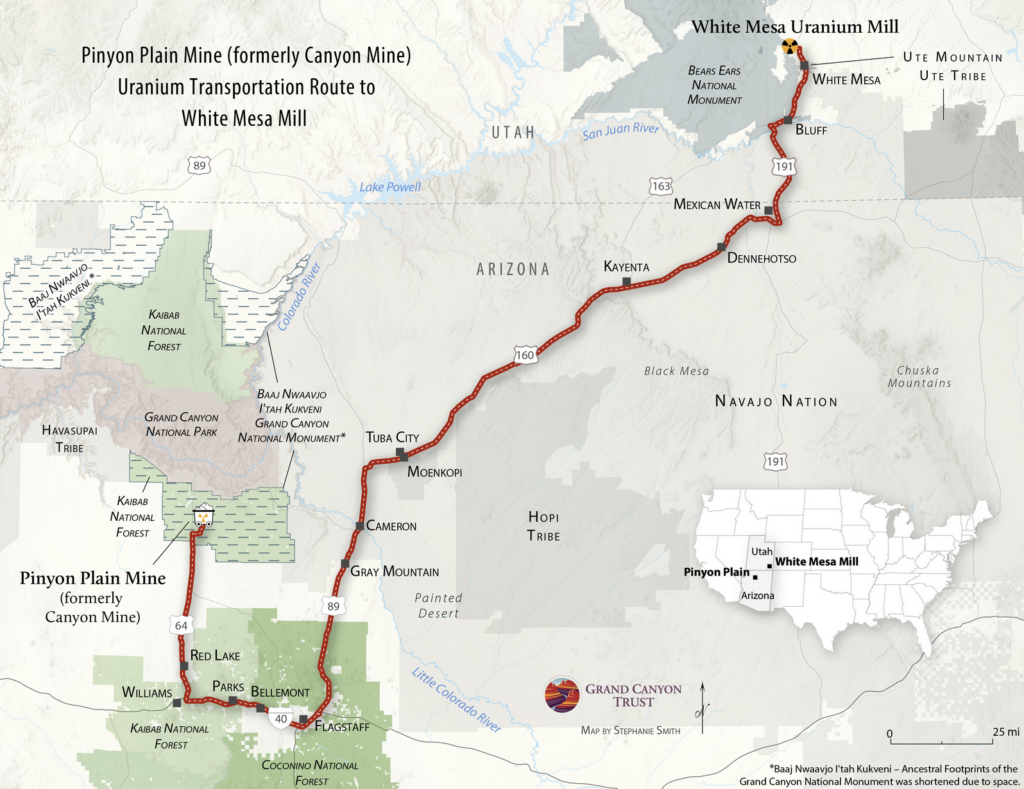F3 Opposes the Pinyon Plain Mine
F3 supports the sovereignty of indigenous tribes and peoples and believes the wishes of Indigenous peoples to close the Pinyon Plain Mine should be honored.
The Havasupai tribe have stated that uranium mining near the Grand Canyon poses real dangers to groundwater in the region. There is a risk of contamination of the ecologically important seeps and springs in the Grand Canyon area, including the Havasupai sole source of water. F3 supports Attorney General Mayes’ demand for an updated Environmental Impact Statement.
F3 also supports the Navajo and Hopi tribes in their efforts to stop the hauling of uranium ore through tribal lands.
We appreciate and support the positions taken by Coconino County (2024) and the City of Flagstaff (2017) to oppose the transportation of uranium ore through Flagstaff and Coconino County.
Background
The Pinyon Plain Mine (formerly named the Canyon Mine), is located six miles south of the south rim of the Grand Canyon. Under the 1872 Mining Law, uranium mining was permitted in 1986 and again in 2022. The operator of the mine is Energy Fuels Resources, a Colorado-based uranium company.
The mine is located below the Havasupai Tribe’s sacred mountain Red Butte, a Traditional Cultural Property on ancestral lands. The land is managed by the US Forest Service and is within the newly designated Baaj Nwaavjo I’tah Kukveni – Ancestral Footprints of the Grand Canyon National Monument designated in 2023. New mining is permanently prohibited in the National Monument, however, the Pinyon Plain Mine was grandfathered in and is legally permitted.
Even though the mine was permitted in 1986, extraction of radioactive uranium ore began for the first time ever in late 2023 as uranium soared to over $90 per pound.
Hauling uranium ore from the mine began on July 30th, 2024, with two trucks making the more than 300-mile journey to the White Mesa uranium mine in southern Utah. The transport route traverses through the Navajo Nation and the Hopi Reservation, as well as Flagstaff.
Communities along the haul route have expressed concerns for decades about public safety and the possibility of accidents involving hauled uranium ore. The uranium industry has a long history of poisoning water and people across the Navajo Nation, where there are over 500 historic abandoned mines needing cleanup. While the Navajo Nation bans uranium mining and transport on its land, the state of Arizona allows uranium to be transported on state highways that run through Navajo land.
On July 31, Navajo Nation President Buu Nygren issued an executive order that requires an agreement be put in place before transportation of radioactive material through the tribe’s land. Arizona Attorney General Kris Mayes publicly expressed concern about the transportation of uranium ore in northern Arizona in a statement on July 31, and Governor Katie Hobbs negotiated a temporary pause to the hauling on August 2, 2024. At least one meeting of involved government agencies and tribes has already taken place and are ongoing.
The City of Flagstaff and the Coconino Board of Supervisors oppose the transport of uranium through the city of Flagstaff and across Indigenous lands, citing concerns about air quality and the health of those along the travel route and supporting advancement of social and environmental justice for Indigenous communities in Northern Arizona.
Aquifer Contamination
The Havasupai Tribe have opposed the Pinyon Plain mine since its inception in1986. The mine sits above the Redwall-Muav Aquifer, the sole water source for the Havasupai Tribe, and the source of many seeps and springs inside Grand Canyon National Park.
Scientists have expressed concern about the potential contamination of the aquifer below the mine. Complex hydrogeology present in the area of the mine has been studied for decades to determine if contaminated groundwater from the mining operation could be flowing into the aquifer.
A recently published paper, “Hydrotectonics of Grand Canyon Groundwater,” indicates that there is a real risk that downward migration of water can occur through natural faults in the stone. One of the authors of this paper indicates that her extensive research suggests that mining for uranium in the Grand Canyon region is too risky to be justified.
The government mandated Environmental Impact Statement (EIS) for the Pinyon Plain mine was completed in 1986 and does not include an analysis of the groundwater studies conducted in the last 35+ years.
Protests and Petition
Several protests against the uranium hauling across tribal lands were organized in Cameron and Flagstaff in early August. Additional community protests are organized for August 24 against the Pinyon Plain mine and haul route, and October 12 against the White Mesa mine.
The Grand Canyon Trust has collected over 17,000 signatures to date on an online petition in opposition to the controversial mine.
To keep up to date on developments regarding the Pinyon Plain mine issues, F3 recommends the Grand Canyon Trust’s Uranium Blog.

